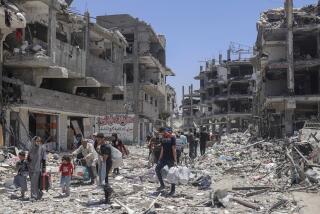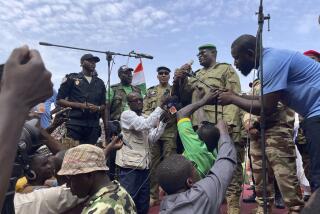Namibia Rebels Misled on Peace Plan, S. Africa Says
- Share via
OSHAKATI, Namibia — Hundreds of armed guerrillas who infiltrated Namibia, touching off bloody fighting and threatening this African territory’s hopes for independence, misunderstood the United Nations’ peace process and thought they could return home with U.N. protection as victors of the war, South African officials and captured rebels said Monday.
As the intense fighting--which has claimed almost 150 lives--continued near this provincial capital for a third day Monday, a picture began to emerge of what triggered the surprise invasion that began shortly after a formal cease-fire between South Africa and the rebel South-West African People’s Organization (SWAPO) was to go into effect. SWAPO had been heavily favored to win Namibia’s first free and fair elections next November.
“Our aim was not to fight. We just came inside to stay inside,” Phillipus Mateus, a 22-year-old rebel captured by Namibian police, told a news conference here Monday. Mateus and a second prisoner also claimed that the South Africa-backed Namibian authorities had fired first and that after their capture they were beaten by police.
“One cannot help but feel compassion for such unnecessary carnage of SWAPO elements,” Roelof F. (Pik) Botha, South Africa’s foreign minister, said in a letter to U.N. Secretary General Javier Perez de Cuellar. The letter, released Monday, said the rebels “obviously had not been informed” by their commanders that they “could have re-entered quite legally” by following steps laid down by the United Nations.
Meanwhile, about 1,500 South African and South African-backed Namibian forces in seven battalions were deployed, with U.N. permission, to track the rebels. Supported by helicopter gunships, the troops included 600 black Namibians recalled to duty from battalions that had been demobilized to comply with the U.N. peace plan.
Chief Inspector Derek Brune of the Namibian police said it was the largest incursion in the 24-year guerrilla war that SWAPO has waged against South African rule. Police said 128 SWAPO guerrillas and 20 police officers had been killed since Saturday. The authorities said they had captured four rebels and about 100 people on both sides had been injured.
The troops and 2,000 Namibian police on Monday were tracking about 1,200 SWAPO guerrillas operating in groups of about 50 in a rugged area of the Angola-Namibia border about 200 miles long and 20 miles deep. Military officers counted “numerous” battles, most ambushes staged by the guerrillas.
“They’re still pushing south,” Drune said. “Our objective is to stop any movement further south and to neutralize them.”
Under the U.N.’s transition plan for Namibian independence, SWAPO’s guerrillas were to retreat north of the 16th Parallel, about 150 miles inside Angola, lay down their arms and return to Namibia beginning in May to participate in the campaign and election for the new nation.
In his letter to Perez de Cuellar, Botha said captured guerrillas said their leaders had ordered them into Namibia to establish bases and told them “they need not fear resistance” and, if there was resistance, “the U.N. would take care of them.”
“The leadership of SWAPO will have to account for their callous disregard for human life and contempt for international agreements,” Botha said. He also criticized the U.N. for not monitoring SWAPO’s confinement to bases north of the 16th Parallel. As many as 5,000 SWAPO troops in Angola--out of a total estimated at 7,500--remain south of the line, Botha said.
SWAPO President Sam Nujoma blamed South Africa for starting the fighting but also criticized the U.N. for allowing South African forces to take the offensive.
“SWAPO is dismayed and shocked. The very forces against which we asked (the U.N.) to protect our people have once again killed,” Nujoma said in Harare, Zimbabwe.
About 1,000 of the 4,650 troops in 20-nation U.N. Transitional Assistance Group have arrived in the country. None has been involved in the fighting, although several hundred are stationed in the north.
In Washington, the State Department blamed SWAPO guerrillas for the fighting and called for an end to the warfare to salvage the Namibian peace settlement.
The prolonged fighting marked a departure for SWAPO forces, which over the years have primarily launched quick, hit-and-run attacks in Namibia from their bases in southern Angola. This time, SWAPO units entered the country at several points along the border and showed no sign of wanting to return to Angola.
Col. Japie Dreyer of the South African Defense Force said it appeared that the guerrillas had strict orders to remain in Namibia and establish bases in the north “to claim they had liberated areas in Owambo (province) and enable them to influence the elections.”
Dreyer defended the South African decision to use force to repel the guerrillas.
“I don’t know how SWAPO could think that they could come in here with 1,200 men, fully armed, and expect us to let them do their own thing,” Dreyer said.
More to Read
Sign up for Essential California
The most important California stories and recommendations in your inbox every morning.
You may occasionally receive promotional content from the Los Angeles Times.











